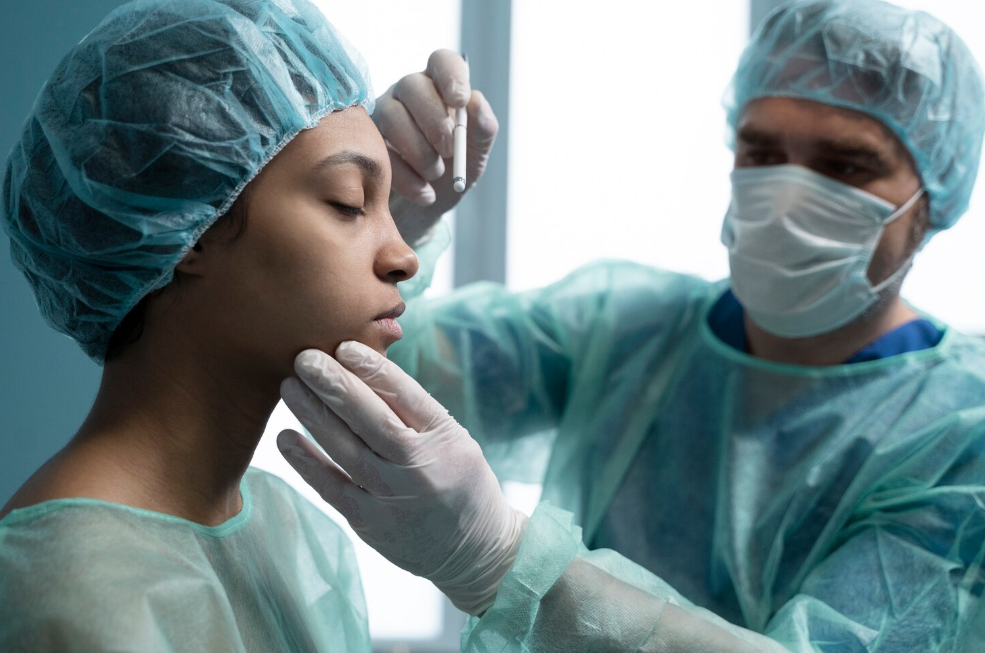Treatment Overview
Bridge Augmentation African Rhinoplasty focuses on enhancing the nasal bridge, which in many African patients is naturally lower, wider, or less defined. Korean surgeons use advanced augmentation techniques such as cartilage grafting, silicone or Gore-Tex implants, and autologous tissue grafts to create a more elevated and defined nasal bridge. The goal is to achieve balance, facial harmony, and improved profile aesthetics while preserving authentic African ethnic features.
Purpose & Benefits
- Increases nasal bridge height for better definition.
- Improves side profile and overall nasal balance.
- Enhances symmetry and proportion between the nose and other facial features.
- Preserves African identity while refining the nose structure.
- Offers long-lasting, natural-looking results with advanced techniques.
Ideal Candidates
- African patients with a naturally low or flat nasal bridge.
- Individuals who feel their nose lacks definition in the profile view.
- Patients who want augmentation while keeping ethnic features intact.
- Healthy candidates seeking permanent and natural-looking refinement.
Possible Risks & Complications
- Temporary swelling, bruising, and discomfort.
- Implant-related risks (shifting, infection, extrusion) if synthetic materials are used.
- Irregularities or asymmetry in bridge height.
- Over-augmentation resulting in an unnatural look.
- Rare cases of prolonged healing or scar formation.
Surgical Techniques Used
- Autologous Cartilage Grafting (Rib, Septal, or Ear Cartilage): Creates a strong and natural nasal bridge.
- Silicone Implant: Commonly used for predictable and smooth augmentation.
- Gore-Tex Implant: Provides a softer, more natural integration with tissue.
- Hybrid Technique: Combination of implant and cartilage for both structure and softness.
- Customized Height Adjustment: Tailored to patient’s desired definition while keeping ethnic authenticity.
Recovery & Aftercare
- Downtime: 7–10 days for initial recovery.
- Bruising & Swelling: Typically subsides within 1–2 weeks.
- Stitches Removal: Around 5–7 days post-surgery.
- Return to Normal Activities: After 1–2 weeks, though avoid strenuous activities for 3–4 weeks.
- Final Results: Noticeable within 3–4 weeks, with continued refinement over 6–12 months.
Korean clinics also provide scar management, swelling control treatments, and long-term aftercare to ensure natural healing.
Results & Longevity
- A higher, more defined nasal bridge.
- Improved facial balance and profile harmony.
- Permanent results with cartilage grafting or long-term stability with high-quality implants.
- Natural preservation of African beauty with enhanced refinement.
Treatment Process in Korea
The journey begins with an in-depth consultation and 3D imaging simulation to design the ideal bridge height. Surgeons evaluate whether an implant, cartilage graft, or a hybrid approach is best suited for the patient.
The procedure usually takes 2–3 hours under general anesthesia or sedation. During surgery, surgeons carefully place the implant or graft along the nasal bridge, ensuring natural integration and symmetry.
After surgery, patients receive personalized care programs including swelling reduction therapies, regular monitoring, and translator assistance for international visitors. Many clinics also provide pick-up services, hotel arrangements, and follow-up support for overseas patients.
Why Korea?
- Specialized Ethnic Rhinoplasty Expertise: Korean surgeons are highly skilled in customizing augmentation for African anatomy.
- Cutting-Edge Technology: 3D planning and digital simulations for precise outcomes.
- Natural Aesthetic Approach: Focus on enhancing definition without over-augmentation.
- Full Medical Tourism Support: Comprehensive services for international patients.
Cost Range
The price of Bridge Augmentation African Rhinoplasty in Korea varies depending on the method and complexity:
- Silicone or Gore-Tex Implant: ₩4,500,000 – ₩6,500,000 KRW ($3,400 – $5,000 USD)
- Autologous Cartilage Grafting (rib or septal): ₩6,000,000 – ₩8,500,000 KRW ($4,600 – $6,500 USD)
- Hybrid Implant + Cartilage Technique: ₩8,000,000 – ₩11,000,000 KRW ($6,100 – $8,400 USD)
Many clinics also offer packages with accommodation, translation, and aftercare support for overseas patients.
Popular Clinics in Korea for Bridge Augmentation African Rhinoplasty
- ID Hospital (Seoul): Renowned for bridge augmentation with both implant and cartilage methods.
- Banobagi Plastic Surgery: Specializes in natural and ethnic-preserving augmentation.
- JW Plastic Surgery: Offers hybrid techniques for African patients seeking balance and refinement.
- View Plastic Surgery: Known for advanced implant customization and 3D planning.
- MINE Plastic Surgery: Provides cartilage-focused augmentation with long-term stability.




